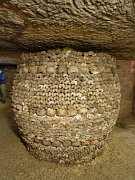The Catacombs of Paris is a famous burial place in Paris, France and although they are most widely known as "the catacombs", the official title is "les Carrieres de Paris", which translates to the quarries of Paris.
It is a network of subterranean tunnels and rooms located in what were Roman-era limestone quarries. The quarries were converted into a mass tomb near the end of the 18th century. The Catacombs gather the remainders of approximately six million Parisian
History Of The Catacombs
The use of the depleted quarries for the storage of bones was established in 1786 by the
order of the Lieutenant General of Police, M Thiroux de Crosne and the Inspector General
of Quarries, Charles Axel Guillaumot.
At the time, the Les Halles district in the middle of the city of Paris was suffering from disease, which was due
to contamination caused by improper burials and mass graves in church graveyards,
especially in the large Saints Innocents Cemetery. So it was decided to remove the
bones discreetly and place them in the abandoned quarries.
The removal of the bones began after the blessing of the place on April 7, 1786 and was continued until 1788, always at night and according to a ceremonial made up of a procession of priests who sang the burial service along the way borrowed by the tipcarts charged with bones and covered with a black veil. Thereafter, this place was used, until 1814, to collect the bones of all the cemeteries of Paris.
Remains from the cemetery of Saint-Nicolas-des-Champs were among the first to be
moved.
Bodies of the dead from the riots in the Place de Greve, the Hotel de Brienne, and Rue
Meslee were put in the catacombs on 28 August and 29 August 1788.
The catacomb walls are covered in graffiti dating from the eighteenth century onwards.
Victor Hugo utilised his knowledge about the tunnel system in Les Miserables.
In 1871 communards killed a group of monarchists in one chamber.
During World War II, Parisian members of
the French Resistance used the tunnel system. Also during this period, German
soldiers established an underground bunker in the catacombs below Lycee Montaigne, which
is a high school in the 6th arrondissement.
However, the underground tunnels and chambers have long posed safety problems for
construction in Paris. Quarries do cave in sometimes, which occasionally result in a
hole in the ground above causing damage to buildings.
To prevent this, in 1777 the IGC (Inspection Generale des Carrieres) was established to
monitor the current quarries and prohibit the digging of new quarries. However, the
IGC did dig some observation tunnels in order to provide themselves with better access to
the quarries so that they could monitor, repair, and map the consolidated quarries.
The monitoring and consolidation work has continued to this day. Because of the
number of quarries, subway tunnels, train tunnels and sewer tunnels that have been dug
underneath Paris, as well as the softness of the stone involved, extra caution is taken
when new construction is attempted or new tunnels are dug.
<\td> |







